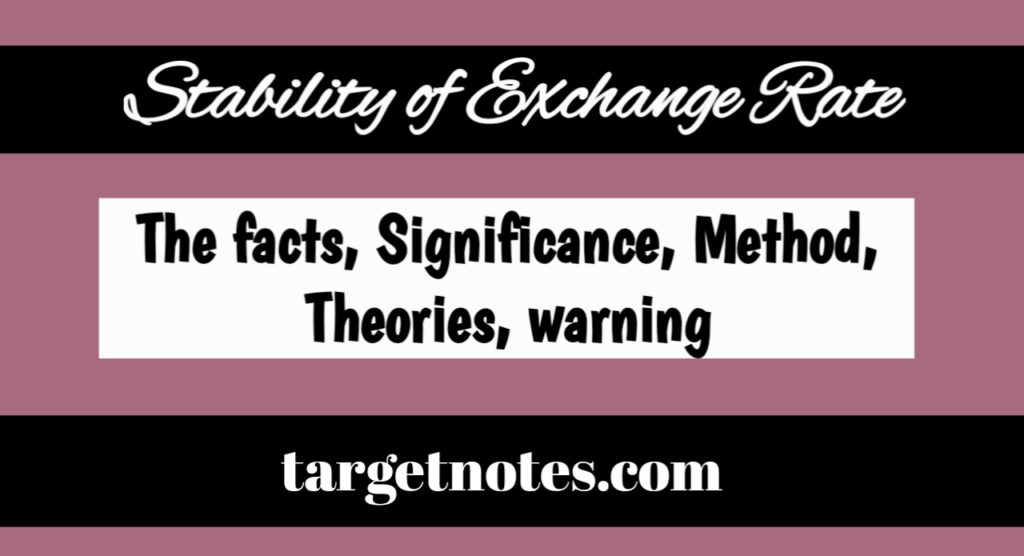
Stability of Exchange Rate
Contents
What do you mean by the Stability of Exchange Rate?
An exchange rate is said to be stable if, with given demand and supply schedules of the home currency in exchange markets, it has no tendency to change. In other words, stability or otherwise of the exchange rate of a currency is determined by the nature of its demand and supply schedules.
The demand curve for Rupees is assumed to be inversely related to its exchange rate; thus giving us a negatively sloped demand curve.
(i) If the supply schedule is positively related to the exchange rate, then the equilibrium is necessarily a stable one. With reference to the point of intersection between demand and supply curves, the demand curve must be above (below) the supply curve to the left (right) of this point.
(ii) If the supply curve is downward sloping, the equilibrium will be stable if the demand is more elastic than supply (that is, the demand curve is flatter than the supply curve).
An exchange rate lower than OA makes the rupee so cheap that demand for rupees exceeds’ their supply, and this pushes the exchange rate upwards. Similarly, a rate higher than OA is a self-correcting one.
(iii) The demand curve for rupees is less elastic than the supply curve. Here, a fall in external value of the Rupee below OA leads to an excess of its supply over its demand and pushes the exchange rate further down.
Correspondingly, an increase in the external value of the Rupee above OA leads to an excess of its demand over its supply and pushes the exchange rate further up.
Exchange rates express the value of one country’s currency in relation to the value of another country’s currency. The rates play an important part in economics, affecting the balance of trade between nations and influencing investment strategies.
The Facts
Exchange rates are the rates at which the currency of one country can be exchanged for the currency of another. Suppose the exchange rate between dollars and Euros was 2 Euros per dollar (always state exchange rates with the foreign currency as a multiple of the dollar). If you walked into an American bank and handed over $15, you would receive 30 Euros. Now suppose that the exchange rate changed to 3 Euros per dollar. If you went to that same bank, they would give you 45 Euros for your $15.
Significance
Exchange rates can be useful if you’re planning a vacation or want to wire money to friends. But it’s also important to businesses when they are trying to determine whether or not to invest in a foreign country and how much. Workers are often wary of taking jobs in countries whose exchange rates fluctuate often and by large amounts.
To understand this concern imagine you are back at the bank. You have your 45 Euros in exchange for $15. If the exchange rate stays at 3 Euros per dollar you could get back your $15. But suppose after you made your first exchange, the rate went to 6 Euros per dollar. When you go to trade back to dollars, you will only get $7.50. If you can image this happening with millions of dollars, you can understand why even small fluctuations in exchange rates would cause concern for investors.
Methods
Countries, especially developing ones, pursue stable exchange rates to attract foreign capital. They usually accomplish this by fixing their currencies to that of a more stable country, a practice called pegging. A country’s central bank may increase or decrease the money supply to maintain this rate. Many countries have their currencies pegged to the U.S. dollar, but some such as China and Kuwait have dropped the connection in recent years as the dollar has lost strength.
Theories/Speculation
Stable exchange rates generally are viewed as favorable, but be drawbacks. An economics principle called the Mundell-Flemming Trilemma states that countries have three economic goals: (1) stable exchange rates, (2) free movement of capital and (3) independent money supply. The Trilemma states that it is only possible to have two of these goals at the same time. The trend in the there can post-World War II economic system has been to have (1) and (2) at the expense of (3).
Warning
Preoccupation with exchange rate stability can exacerbate other economic problems. In the late 1990s, Argentina had inflation problems that could have been eased if the government had adjusted the money supply. But this strategy was not pursued partly because of concerns about exchange rate stability.
Important Link
- Kinds of Disequilibrium in Balance of payments (BOP)
- Measures Adopted by Government of India to Correct its Adverse BOP
- Balance of Payments: Meaning, Definitions, Characteristics and Uses
- Different Terms of Payment used in Foreign Trade
- Characteristics of Export Documents
- Letter of Credit: Meaning, Importance and Required Document
- Documents used in export trade its types and contents
- Restrictions on deposits to foreign currency accounts
- What is the obligation to submit foreign currency?
- Foreign Exchange: Concept, Example and Needs
Disclaimer






